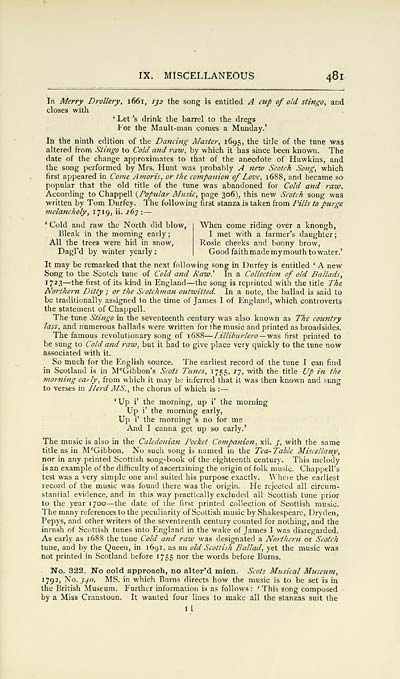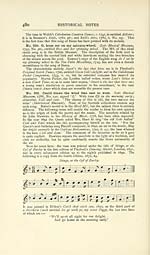Glen Collection of printed music > Printed music > Songs of Robert Burns
(537) Page 481
Download files
Complete book:
Individual page:
Thumbnail gallery: Grid view | List view

IX. MISCELLANEOUS
481
In Men^y Drollery, 1661, 132 the song is entitled A cup of old stingo, and
closes with
' Let 's drink the barrel to the dregs
Per the Mault-man comes a Munday.'
In the ninth edition of the Dancutg Master, 1695, the title of the tune was
altered from Stingo to Cold and raw, by which it has since been known. The
date of the change approximates to that of the anecdote of Hawkins, and
the song performed by Mrs. Hunt was probably A new Scotch Sottg, which
first appeared in Come Amoris, or the companion of Love, 1688, and became so
popular that the old title of the tune was abandoned for Cold and raw.
According to Chappell {Popular Music, page 306), this new Scotch song was
written by Tom Durfey. The following first stanza is taken from Pills to purge
melancholy, 1719, ii. 16'j : —
' Cold and raw the North did blow,
Bleak in the morning early ;
All the trees were hid in snow,
Dagl'd by winter yearly :
When come riding over a knough,
I met with a farmer's daughter;
Rosie cheeks and bonny brow,
Good faithmademymouth to water.'
It may be remarked that the next following song in Durfey is entitled ' A new
Song to the Scotch tune of Cold and Raw.'' In a Collection of old Ballads,
1723 — the first of its kind in England — the song is reprinted with the title The
Northern Ditty ; or the Scotchman outwitted. In a note, the ballad is said to
be traditionally assigned to the time of James I of England, which controverts
the statement of Chappell.
The tune Stingo in the seventeenth century was also known as The country
lass, and numerous ballads were written for the music and printed as broadsides.
The famous revolutionary song of 1688 — Lilliburlero—\izs first printed to
be sung to Cold and raw, but it had to give place very quickly to the tune now
associated with it.
So much for the English source. The earliest record of the tune I can find
in Scotland is in M'^Gibbon's Scots Tunes, 1755, i"], with the title Up in the
morning early, from which it may be inferred that it was then known and sung
to verses in Herd MS., the chorus of which is : —
'Up i' the morning, up i' the morning
Up i' the morning early,
Up i' the morning 's no for me
And I canna get up so early.'
The music is also in the Caledonian Pocket Companion, xii. /, with the same
title as in M"Gibbon. No such song is named in the Tea-Table Miscellany,
nor in any printed Scottish song-book of the eighteenth century. This melody
is an example of the difficulty of ascertaining the origin of folk music. Chappell's
test was a very simple one and suited his purpose exactly. Where the earliest
record of the music was found there was the origin. He rejected all circum-
stantial evidence, and in this way practically excluded all Scottish tune prior
to the year 1700 — the date of the first printed collection of Scottish music.
The many references to the peculiarity of Scottish music by Shakespeare, Dryden,
Pepys, and other writers of the seventeenth century counted for nothing, and the
inrush of Scottish tunes into England in the wake of James I was disregarded.
As early as 1688 the tune Cold and raw was designated a Northern or Scotch
tune, and by the Queen, in 1691, as an old Scottish Ballad, yet the music was
not printed in Scotland before 1755 nor the words before Burns.
No. 322. No cold approach, no alter'd mien. Scots Musical Mtiseum,
i'jg2. No. j^o. MS. in which Burns directs how the music is to be set is in
the British Museum. Further information is as follows : ' This song composed
by a Miss Cranstoun. It wanted four lines to make all the stanzas suit the
I i
481
In Men^y Drollery, 1661, 132 the song is entitled A cup of old stingo, and
closes with
' Let 's drink the barrel to the dregs
Per the Mault-man comes a Munday.'
In the ninth edition of the Dancutg Master, 1695, the title of the tune was
altered from Stingo to Cold and raw, by which it has since been known. The
date of the change approximates to that of the anecdote of Hawkins, and
the song performed by Mrs. Hunt was probably A new Scotch Sottg, which
first appeared in Come Amoris, or the companion of Love, 1688, and became so
popular that the old title of the tune was abandoned for Cold and raw.
According to Chappell {Popular Music, page 306), this new Scotch song was
written by Tom Durfey. The following first stanza is taken from Pills to purge
melancholy, 1719, ii. 16'j : —
' Cold and raw the North did blow,
Bleak in the morning early ;
All the trees were hid in snow,
Dagl'd by winter yearly :
When come riding over a knough,
I met with a farmer's daughter;
Rosie cheeks and bonny brow,
Good faithmademymouth to water.'
It may be remarked that the next following song in Durfey is entitled ' A new
Song to the Scotch tune of Cold and Raw.'' In a Collection of old Ballads,
1723 — the first of its kind in England — the song is reprinted with the title The
Northern Ditty ; or the Scotchman outwitted. In a note, the ballad is said to
be traditionally assigned to the time of James I of England, which controverts
the statement of Chappell.
The tune Stingo in the seventeenth century was also known as The country
lass, and numerous ballads were written for the music and printed as broadsides.
The famous revolutionary song of 1688 — Lilliburlero—\izs first printed to
be sung to Cold and raw, but it had to give place very quickly to the tune now
associated with it.
So much for the English source. The earliest record of the tune I can find
in Scotland is in M'^Gibbon's Scots Tunes, 1755, i"], with the title Up in the
morning early, from which it may be inferred that it was then known and sung
to verses in Herd MS., the chorus of which is : —
'Up i' the morning, up i' the morning
Up i' the morning early,
Up i' the morning 's no for me
And I canna get up so early.'
The music is also in the Caledonian Pocket Companion, xii. /, with the same
title as in M"Gibbon. No such song is named in the Tea-Table Miscellany,
nor in any printed Scottish song-book of the eighteenth century. This melody
is an example of the difficulty of ascertaining the origin of folk music. Chappell's
test was a very simple one and suited his purpose exactly. Where the earliest
record of the music was found there was the origin. He rejected all circum-
stantial evidence, and in this way practically excluded all Scottish tune prior
to the year 1700 — the date of the first printed collection of Scottish music.
The many references to the peculiarity of Scottish music by Shakespeare, Dryden,
Pepys, and other writers of the seventeenth century counted for nothing, and the
inrush of Scottish tunes into England in the wake of James I was disregarded.
As early as 1688 the tune Cold and raw was designated a Northern or Scotch
tune, and by the Queen, in 1691, as an old Scottish Ballad, yet the music was
not printed in Scotland before 1755 nor the words before Burns.
No. 322. No cold approach, no alter'd mien. Scots Musical Mtiseum,
i'jg2. No. j^o. MS. in which Burns directs how the music is to be set is in
the British Museum. Further information is as follows : ' This song composed
by a Miss Cranstoun. It wanted four lines to make all the stanzas suit the
I i
Set display mode to: Large image | Transcription
Images and transcriptions on this page, including medium image downloads, may be used under the Creative Commons Attribution 4.0 International Licence unless otherwise stated. ![]()
| Special collections of printed music > Glen Collection of printed music > Printed music > Songs of Robert Burns > (537) Page 481 |
|---|
| Permanent URL | https://digital.nls.uk/91266086 |
|---|
| Description | Scottish songs and music of the 18th and early 19th centuries, including music for the Highland bagpipe. These are selected items from the collection of John Glen (1833 to 1904). Also includes a few manuscripts, some treatises, and other books on the subject. |
|---|
| Description | The Glen Collection and the Inglis Collection represent mainly 18th and 19th century Scottish music, including Scottish songs. The collections of Berlioz and Verdi collected by bibliographer Cecil Hopkinson contain contemporary and later editions of the works of the two composers Berlioz and Verdi. |
|---|

